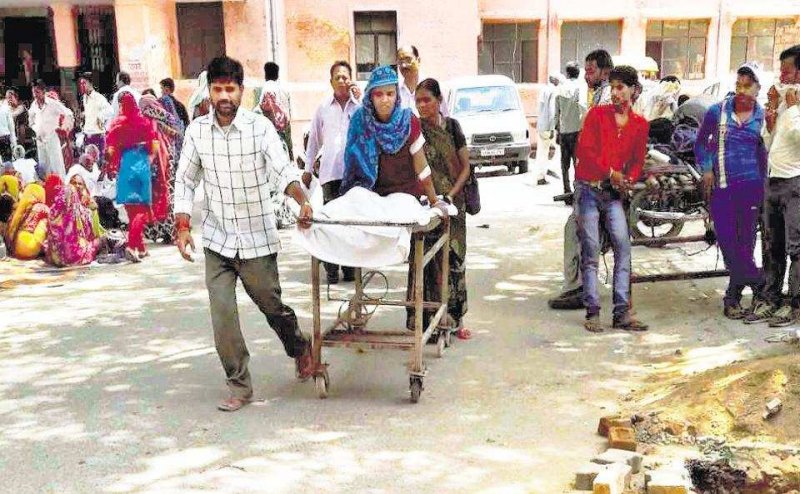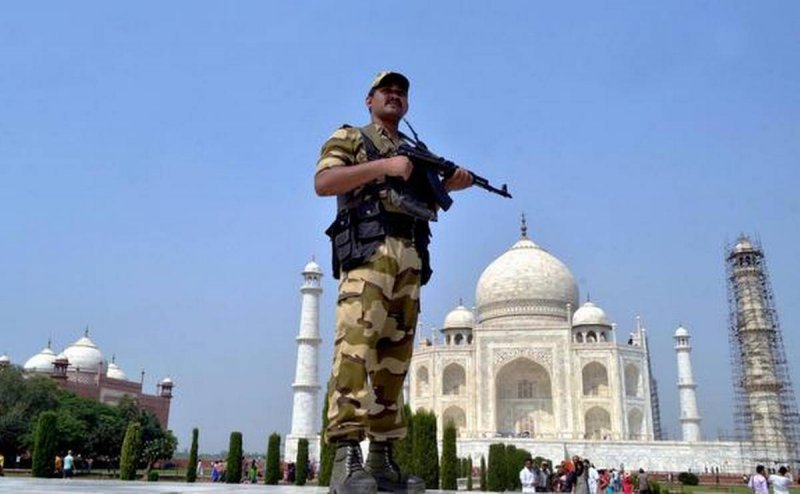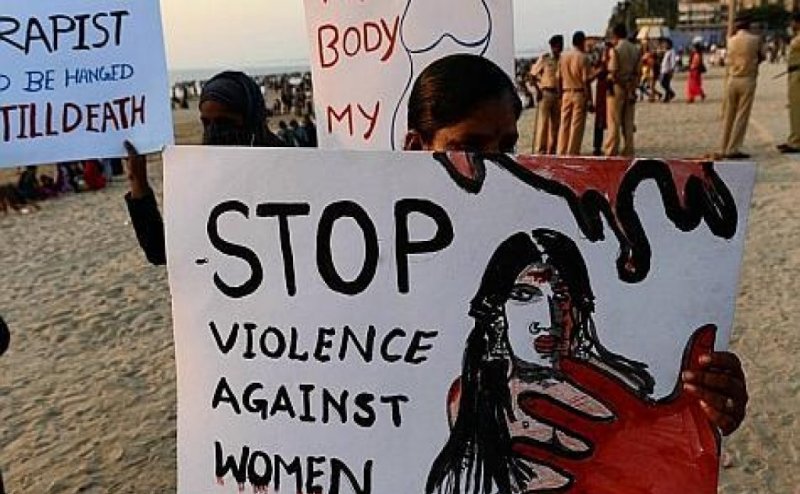UP’s healthcare is seriously sick, needs urgent treatment
- | Wednesday | 29th August, 2018

The BJP when came to power in Uttar Pradesh in 2017, it promised in its manifesto, that it will provide a primary sub centre in all villages with the latest equipment and technology. Further, it promised to set up 25 new medical colleges and specialty hospitals and one hospital at par with the All India Institute of Medical Sciences in every six blocks. The BJP has promised to turn UP into a malnutrition-free state in five years. By Alok Verma
Yogi Adityanath, the Chief Minister of Uttar Pradesh (UP), reaffirmed his government’s commitment to a major revamp of the healthcare sector in the state after completing one year of his term in office. However, none of the big promises made by the Yogi Government has so far not made any major visible progress on the ground. In majority of districts in UP the healthcare system in tatters.
The state health ministry is trying to overcome the multiple challenges of shortage of doctors and poor healthcare infrastructure. The government is seeking to upgrade the existing hospitals and overcome a shortage of 7000 doctors and 18000 paramedical staffs. This process, if completed, would be a welcome change in the most populous state in the country, which has been devoid of affordable, accessible and quality healthcare for decades. The state battles daunting health challenges – incompetent and insufficient healthcare centres, staff, medicines and medical equipment.


Some of the recent incidents of medical negligence has put a question mark on the credibility of the state government’s healthcare machinery. Example 1: A few months back, a government probe was ordered into reports claiming that 32 cataract patients were operated using a torch light for want of steady electricity supply at a state-run facility in Uttar Pradesh’s Unnao district. According to the reports, the operations were done at the community health centre (CHC) in Nawabganj on Monday in torch light as there was no electricity or power back-up there. Nawabganj, like many rural areas of Uttar Pradesh, gets electricity for only 12 hours a day. A five-bed facility, the Nawabganj primary healthcare centre (PHC) took in 32 patients even though it is not equipped for eye surgeries.
Example 2: In August 2017—Yogi Adityanath government faced a major crises when more than 30 children died within a span of 48 hours at the government-run Baba Raghav Das (BRD) Medical College hospital in Gorakhpur. The tragedy took deaths due to shoddy healthcare in the state to 1,304 in 2017.
The Allahabad High Court judges Justice Sudhir Agarwal and Justice Ajit Kumar came down heavily on the State Government while hearing petition of a woman brick kiln labourer, who was traumatized and neglected in the primary health centre alleging violation of fundamental rights, including the Right to life. The High Court observed, “If in one word we have to describe State Medical Services, it is quite apt to use the word for its functioning on its destiny and fate – Ram Bharose (Dependent on God).”
Bare Facts: UP has India’s second highest maternal mortality rate
Despite having the largest population, UP spends Rs 452 per capita on health, 70% less than the average spending by states.
One in two children in the state is not fully immunised, and the state has India’s second highest maternal mortality rate (258 deaths per 100,000 live births) and highest infant mortality rate (64 deaths per 1,000 live births), according to the National Family Health Survey, 2015-16 (NFHS-4).
There are 84% fewer specialists than needed, 50% fewer nursing staff, and the lowest share of health workers (19.9%) in India, found an analysis by the Observer Research Foundation in February 2017.
As many as 46.3% of UP’s children are stunted (low height-for-age), 17.9% are wasted (low weight-for-height) and 39.5% of its children are underweight, according to NFHS-4.
What Ails Uttar Pradesh
In Uttar Pradesh, private health providers — including unrecognized doctors and quacks — meet 85 percent of medical needs, according to the report. It appears that the people of Uttar Pradesh have two choices: An inadequate, inefficient public healthcare system and a private healthcare system offering low quality and expensive services.
Acute manpower shortage, the fact that a vast majority of people do not have health insurance in a country where the public health system has collapsed and a lack of political will to fix the healthcare system has provided space for such tragedies to frequently resurface. In India, the private healthcare system now provides two-thirds of medical treatment, according to the April 2016 Health in India report from the Ministry of Statistics and Programme Implementation.
Currently, the state relies on a public healthcare infrastructure that is two decades old. A fifth of the population deprived of healthcare cannot contribute to the social or economic growth of the country. The situation is so worse in UP that around 50 out of every 1,000 children die before they reach the age of five.
However, the deplorable condition of healthcare system in Uttar Pradesh is not about oxygen cylinders and unpaid bills. India’s abysmally low public spending on healthcare is at the root of the problems. Over the past nine years, Indiaspend reported, there has been almost no upgradation of institutions offering basic healthcare. No more than four of 773 CHCs are adequately staffed and serviced with drugs and supplies, according to this 2015-16 report of the National Rural Health Mission (NRHM); 467 CHCs did not have minimum infrastructure and staff. Medical and paramedical staff–in short supply across India, as IndiaSpend reported, are in particularly short supply in Uttar Pradesh, especially the rural areas.
Healthcare has been low on the priorities of successive Uttar Pradesh governments. An Indiaspend report said that the per capita expenditure on health in Uttar Pradesh increased from Rs 260 to Rs 372 over four years to 2010, according to the 2012 National Institute of Public Finance and Policy report, compared to Rs 356 to Rs 580 in Kerala and from Rs 299 to Rs 579 in Tamil Nadu over the same period. Among the major states of India, Uttar Pradesh, Assam, Madhya Pradesh and Odisha account for the lowest life expectancy at birth, in contrast to the decade-long progress evident in most southern, western and eastern states.
What are the reasons for Uttar Pradesh’s poor healthcare record?
A combination of several factors, such as a shortage of healthcare professionals, increasing cost of healthcare, the mushrooming of private healthcare and a lack of planning. A third of the rural population in the state has been deprived of primary healthcare infrastructure, according to the norms of the Indian Public Health Standards (IPHS), which sets infrastructural and human resource standards for public health institutions in India.
Uttar Pradesh requires 31,037 sub-centres, 5,172 PHCs and 1,293 CHCs to meet the healthcare demands of its population. But the state is 33 percent short of sub-centres and PHCs and 40 percent short of CHCs, according to RHS-2015 data. This shortage of public healthcare institutions further impacts the implementation of centrally sponsored health programmes, which in turn, require an effective network of public health institutions. Successive state governments have failed to plan, prioritize and understand healthcare needs.
The Ailing Healthcare Sector of UP
A brief study of the basic health infrastructure and basic health indicators like the Infant Mortality Rate (IMR) and Maternal Mortality Rate (MMR) illustrates the bleak condition of healthcare in UP. In 2005, UP was one of the eight states identified as the Empowered Action Group (EAG) states based on their dismal health indicators. Data from the Annual Health Survey (AHS) 2012–13 reveal that UP continues to be one of the poorest performing states, lagging behind the national average on most of these indicators.
Inadequate Healthcare Infrastructure
The Sub Centres (SCs), Primary Health Centres (PHCs) and Community Health Centres (CHCs) are the various interfaces of the government’s healthcare system. These centres at various levels are supposed to provide affordable and quality healthcare accessible to all. According to the Census 2011, 22.27 per cent of the state’s population lived in urban areas and 77.73 per cent of the state’s population lived in rural areas. However, the state has only one PHC per 28 villages or 44597 people.
Over the decades, the number of health centres in the state has increased only marginally. Even though the number of CHCs has increased from 515 in the period 2007–12 to 773 in 2012–17, the growth appears trivial, when the huge population of the state is taken into account.
PHCs and CHCs are inadequately staffed and together account for only half the combined strength of staff. Considering that UP contributes to 16.6 per cent of the country’s population, it has only 10.81 per cent of health workers. According to the Rural Health Statistics 2016, CHCs in UP reported a shortage of 84 per cent of specialists. In terms of density of nurses, most of the 30 districts with the lowest numbers were located in UP, followed by Bihar and Jharkhand. According to a World Health Organisation (WHO) study of 2016, UP has the lowest share of female health workers of 19.9 per cent, compared with the Indian average of 38 per cent.
Infant Mortality Rate
Data from Rural Health Statistics 2015 reveal that UP has the second highest IMR (deaths per 1000 live births) across rural and urban areas in the country. Over the decades, UP has recorded higher IMR across genders than the national average. A newborn in UP is expected to live four years fewer than in the neighbouring state of Bihar, five years fewer than in Haryana and seven years fewer than in Himachal Pradesh.
Maternal Mortality Rate
The state also accounts for the second highest MMR in the country with 285 maternal deaths for every 100,000 live births. UP has the highest child mortality indicator, from the Neonatal Mortality Rate (NNMR) to the less-than-five mortality rate.
Although the MMR dropped from 212 deaths in 2007–09 to 178 deaths in 2010–12, India is lagging behind the target of 103 deaths per 100,000 live births, which was to be achieved by 2015 under the United Nations-mandated Millennium Development Goals (MDG).
Diseases and Deaths
UP contributed to the largest share of deaths, due to communicable and non-communicable diseases, including 48 per cent of typhoid deaths (2014), 17 per cent of cancer deaths and 18 per cent of tuberculosis deaths (2015).
In 2016, of the total number of 1277 Acute Encephalitis Syndrome (AES) cases reported in India, 615 were reported in UP. The state also accounts for more than 75 per cent of Japanese Encephalitis (JE) cases. Of the total number of 275 deaths due to JE, 73 were reported in UP.
The dismal performance of the state’s healthcare sector has continued unabated over the last few decades. Evidently, the successive governments in the state have failed to provide quality healthcare to the people. One major reason can be the below-par expenditure on health by the state. UP spends an average of 4.7 per cent of its social sector expenditure on public healthcare and family welfare annually. This is marginally less than the national average of 4.8 per cent.
Although the incumbent UP government, which has alleged that it has inherited ‘a completely broken system’, has been making efforts to upgrade the state’s healthcare network from basic PHCs to multispecialty hospitals by emphasizing on maximum use of technology in healthcare, the outcome of its efforts will heavily depend on the strong will of UP government to develop a state-specific health policy, which would cater to its unique health challenges.

If You Like This Story, Support NYOOOZ
Your support to NYOOOZ will help us to continue create and publish news for and from smaller cities, which also need equal voice as much as citizens living in bigger cities have through mainstream media organizations.
Stay updated with all the Agra Latest News headlines here. For more exclusive & live news updates from all around India, stay connected with NYOOOZ.










